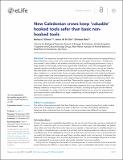Files in this item
New Caledonian crows keep 'valuable' hooked tools safer than basic non-hooked tools
Item metadata
| dc.contributor.author | Klump, Barbara C. | |
| dc.contributor.author | St Clair, James | |
| dc.contributor.author | Rutz, Christian | |
| dc.date.accessioned | 2021-12-21T13:30:05Z | |
| dc.date.available | 2021-12-21T13:30:05Z | |
| dc.date.issued | 2021-12-21 | |
| dc.identifier | 275996072 | |
| dc.identifier | c73735fc-b599-4391-bab9-da6d40ae478e | |
| dc.identifier | 85122144393 | |
| dc.identifier.citation | Klump , B C , St Clair , J & Rutz , C 2021 , ' New Caledonian crows keep 'valuable' hooked tools safer than basic non-hooked tools ' , eLife , vol. 10 , e64829 . https://doi.org/10.7554/eLife.64829 | en |
| dc.identifier.issn | 2050-084X | |
| dc.identifier.other | ORCID: /0000-0001-5187-7417/work/105318371 | |
| dc.identifier.uri | https://hdl.handle.net/10023/24553 | |
| dc.description | Funding: This study was funded through a BBSRC David Phillips Fellowship (BB/G023913/1 and /2 to CR) and a PhD studentship from the BBSRC and the University of St Andrews (to BCK). During the final stages of manuscript preparation, CR was the grateful recipient of a Radcliffe Fellowship at the Radcliffe Institute for Advanced Study, Harvard University, and a BBSRC grant (BB/S018484/1). | en |
| dc.description.abstract | The temporary storage and re-use of tools can significantly enhance foraging efficiency. New Caledonian crows in one of our study populations use two types of stick tools – hooked and non-hooked – which differ in raw material, manufacture costs, and foraging performance. Using a large sample of wild-caught, temporarily captive New Caledonian crows, we investigated experimentally whether individuals prefer one tool type over the other when given a choice and whether they take better care of their preferred tools between successive episodes of use, safely storing them underfoot or in nearby holes. Crows strongly preferred hooked stick tools made from Desmanthus virgatus stems over non-hooked stick tools. Importantly, this preference was also reflected in subsequent tool-handling behaviour, with subjects keeping hooked stick tools safe more often than non-hooked stick tools sourced from leaf litter. These results suggest that crows ‘value’ hooked stick tools, which are both costlier to procure and more efficient to use, more than non-hooked stick tools. Results from a series of control treatments suggested that crows altered their tool ‘safekeeping’ behaviour in response to a combination of factors, including tool type and raw material. To our knowledge, our study is the first to use safekeeping behaviour as a proxy for assessing how non-human animals value different tool types, establishing a novel paradigm for productive cross-taxonomic comparisons. | |
| dc.format.extent | 17 | |
| dc.format.extent | 1000296 | |
| dc.language.iso | eng | |
| dc.relation.ispartof | eLife | en |
| dc.subject | Corvid | en |
| dc.subject | Corvus moneduloides | en |
| dc.subject | Extractive foraging | en |
| dc.subject | Optimal foraging | en |
| dc.subject | Tool manufacture | en |
| dc.subject | Tool use | en |
| dc.subject | Utility | en |
| dc.subject | QL Zoology | en |
| dc.subject | DAS | en |
| dc.subject | MCC | en |
| dc.subject.lcc | QL | en |
| dc.title | New Caledonian crows keep 'valuable' hooked tools safer than basic non-hooked tools | en |
| dc.type | Journal article | en |
| dc.contributor.sponsor | BBSRC | en |
| dc.contributor.sponsor | BBSRC | en |
| dc.contributor.institution | University of St Andrews. Centre for Biological Diversity | en |
| dc.contributor.institution | University of St Andrews. Centre for Social Learning & Cognitive Evolution | en |
| dc.contributor.institution | University of St Andrews. School of Biology | en |
| dc.identifier.doi | 10.7554/eLife.64829 | |
| dc.description.status | Peer reviewed | en |
| dc.identifier.grantnumber | BB/G023913/2 | en |
| dc.identifier.grantnumber | BB/S018484/1 | en |
This item appears in the following Collection(s)
Items in the St Andrews Research Repository are protected by copyright, with all rights reserved, unless otherwise indicated.

